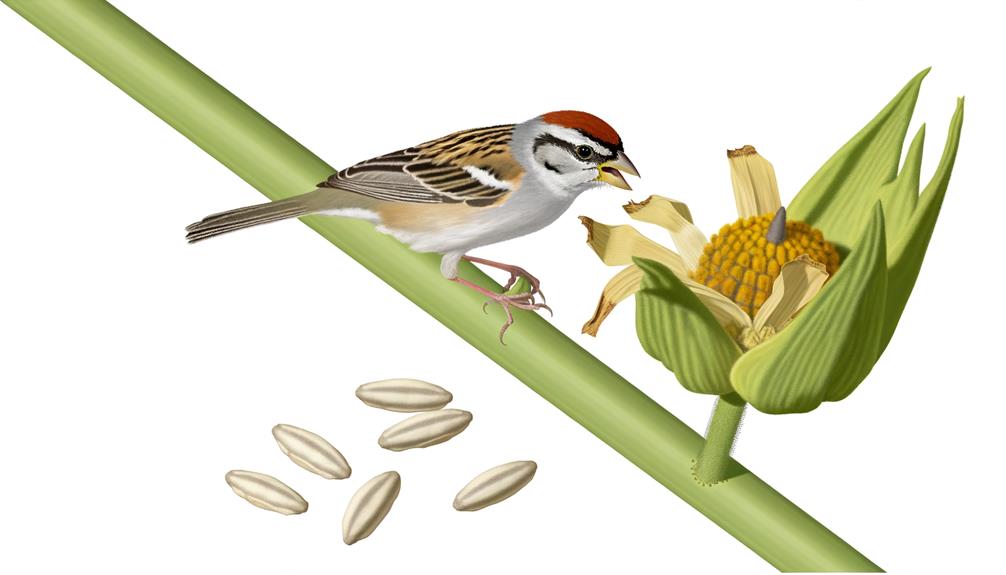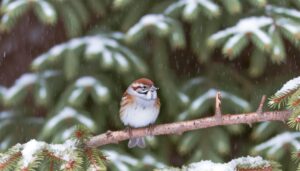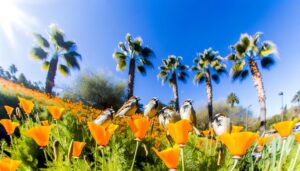How Do Chipping Sparrows Eat Safflower Seeds?
Yes, Chipping Sparrows do eat safflower seeds. They've shown a clear preference for this seed type, which is rich in beneficial fatty acids and protein, elements necessary for their daily energy levels and overall health.
Their feeding habits change with the seasons, but safflower seeds remain a staple throughout. Studying the Chipping Sparrow's dietary adaptability reveals fascinating information about their survival capabilities.
If one wishes to attract these sparrows, providing a consistent supply of safflower seeds can prove fruitful. There's a wealth of insight to be gained on the interrelation between safflower seeds and these sparrows' wellbeing.

Key Takeaways
- Chipping Sparrows have a preference for safflower seeds, making them a staple in their diet.
- Safflower seeds are rich in fats and proteins, providing the sparrows with essential nutrients for energy, growth, and immune function.
- In the winter, when insects are less available, Chipping Sparrows adapt their diet to consume more seeds and grains, including safflower.
- Providing a diet rich in safflower seeds in an accessible bird feeder can attract more Chipping Sparrows.
- Understanding the Chipping Sparrow's preference for safflower seeds can help in creating effective bird feeding strategies.
Understanding the Chipping Sparrow
The Chipping Sparrow, a small and active bird species, exhibits unique feeding habits that are worth understanding for any bird enthusiast or researcher. They're known for their adaptability, often altering their diet based on what's available in their environment.
This species isn't picky eaters – they've been observed consuming a wide range of food items, from seeds and berries to insects. However, they tend to prefer a plant-based diet, particularly during non-breeding seasons.
The Chipping Sparrow's feeding behavior also shows a level of sophistication. They're opportunistic feeders, often seen foraging on the ground or gleaning from vegetation. Understanding their dietary preferences and feeding habits is essential in providing appropriate food sources, ensuring their survival and conservation.
Chipping Sparrow's Natural Diet
In the Chipping Sparrow's natural diet, seed preference plays a pivotal role. The impact of safflower seeds, a popular choice in bird feeders, on the Sparrow's dietary habits necessitates thorough investigation.
The potential variations in Sparrow diets across different regions and seasons further add complexity to this study.
Seed Preferences in Sparrows
Dietary preferences among Chipping Sparrows reveal a distinct inclination towards seeds, especially those of the safflower plant, forming an essential part of their natural diet. These birds have adapted to a seed-eating lifestyle, showing a preference for small, easily digestible seeds.
Besides safflower seeds, their diet also includes millet, sunflower, and grass seeds. Though they occasionally consume insects, seeds remain their primary food source, crucial for their survival and reproduction.
Among all seeds, safflower seems to top the list, with sparrows often seen gorging on them. It's not just the taste, but the nutritional value of safflower seeds, rich in fats and proteins, that attract these sparrows.
This diet pattern, while varied, showcases a clear affinity towards certain seeds, most notably safflower.
Impact of Safflower Seeds
Building on their dietary preferences, it's worth exploring how safflower seeds, a staple in the Chipping Sparrow's diet, impact their overall health and behavior.
Safflower seeds are packed with healthy fats, proteins, and antioxidants. These nutrients are necessary for the birds' survival, contributing to their energy levels, feather health, and immune function.
The high fat content provides the necessary energy for their daily activities and long distance flights. The protein supports growth and repair, particularly during the molting period.
Additionally, antioxidants in safflower seeds help combat oxidative stress in sparrows, an essential aspect in maintaining their overall health. Hence, incorporating safflower seeds in their diet enhances the Chipping Sparrows' well-being and vitality.
Variations in Sparrow Diets
While safflower seeds play a vital role in the Chipping Sparrow's diet, these birds also consume a diverse range of other foods in their natural habitat. They're known to eat a variety of insects, including beetles, caterpillars, and spiders. During winter, their diet shifts mainly to seeds and grains.
To understand this better, let's explore a brief comparison of their summer and winter diets:
| Season | Predominant Diet |
|---|---|
| Summer | Insects (beetles, caterpillars, spiders) |
| Winter | Seeds and grains (including safflower) |
In essence, Chipping Sparrows have a varied diet that adapts to seasonal availability. This flexibility in their diet allows them to thrive in various environments and conditions. Therefore, while safflower seeds are important, they're just one part of a Chipping Sparrow's diverse dietary repertoire.
Safflower Seeds: Nutritional Facts
Safflower seeds, the Chipping Sparrow's dietary staple, are packed with an impressive array of nutrients, providing essential vitamins and minerals needed for their overall health and well-being.
These seeds are rich in beneficial fatty acids, including linoleic acid, which plays a pivotal role in maintaining healthy feathers and skin. They're an excellent source of protein, crucial for muscle growth and repair.
The high fiber content aids in digestion, while the presence of calcium strengthens their bones. Safflower seeds also contain a significant amount of Vitamin E, an antioxidant that helps protect the sparrows' bodies from harmful free radicals.
Iron, a mineral found in these seeds, contributes to the production of red blood cells, supporting the birds' cardiovascular health.
Safflower Seeds and Sparrows
In the context of the Chipping Sparrow's dietary habits, the inclusion of safflower seeds appears to be a significant element. These seeds not only align with sparrows' food preferences but also offer considerable nutritional benefits.
The focus moving forward will be to explore these benefits and how they influence the dietary choices of Chipping Sparrows.
Sparrows' Dietary Preferences
Chipping sparrows show a strong preference for safflower seeds, making them a significant part of their diet. This preference isn't accidental; it's a result of the bird's natural instinct to seek out food sources that provide excellent nutrition. Safflower seeds are high in fat and protein, crucial nutrients for the sparrow's survival.
Their feeding habits are also influenced by the availability of food sources. In environments where safflower seeds are easily accessible, sparrows will consume them frequently.
It's important to note that while safflower seeds are a preferred food, sparrows have a varied diet that includes other seeds, insects, and fruits. This dietary diversity helps guarantee sparrows receive a balanced intake of nutrients necessary for their health and well-being.
Safflower Seeds Benefits
While sparrows enjoy a variety of foods, it's the nutritional benefits of safflower seeds that make them a standout choice in their diet.
Safflower seeds are packed with essential nutrients, including proteins, fats, and carbohydrates, critical to a sparrow's health and strength. They're particularly rich in unsaturated fats, which aid in keeping the bird's plumage glossy and healthy.
Additionally, safflower seeds provide essential vitamins and minerals, such as Vitamin E and magnesium. Vitamin E acts as an antioxidant while magnesium aids in muscle function and bone health.
These seeds also contain beneficial dietary fiber which aids in digestion. Therefore, safflower seeds offer a well-rounded nutritional profile that supports the overall health and well-being of sparrows.
Chipping Sparrows' Food Choices
Sparrows, especially the Chipping variety, have shown a distinct preference for safflower seeds, attracted by their rich nutritional profile that supports their health and well-being. These tiny birds possess an ability to crack open the tough exteriors of the seeds, gaining access to the nutrient-dense insides. Safflower seeds provide an abundant supply of proteins, fats, and minerals essential for the sparrows' survival, especially during the harsh winter months.
Interestingly, not all avian species show the same fondness for safflower. The seed's bitter taste deters certain birds, making safflower an ideal choice for feeders intended specifically for sparrows.
Using safflower seeds can help in maintaining a more controlled bird population in your backyard, attracting only those species that enjoy its specific taste and nutritional benefits.
Encouraging Chipping Sparrows: Feeding Tips
To encourage the presence of Chipping Sparrows in your garden, one effective method is to provide a diet rich in safflower seeds, which these birds find particularly appealing. Placing the seeds in a bird feeder that's easy for them to access is crucial. Elevated platform feeders are suitable because they mimic the natural foraging habits of Chipping Sparrows, thereby enhancing their comfort level.
Keep the feeder clean and free of waste to prevent the spread of diseases among the birds. Regular refill is also important to maintain a steady food source. Additionally, providing fresh water nearby can attract more sparrows.
Analyzing Chipping Sparrow's Food Preferences
Now, let's analyze the food preferences of Chipping Sparrows, expanding our understanding beyond their fondness for safflower seeds. Their diet is diverse and season-dependent. In summer, these sparrows consume a large amount of insects, while in winter, they rely more on seeds and grains.
Here's a table showing their food preferences:
| Season | Primary Food | Secondary Food |
|---|---|---|
| Summer | Insects | Safflower seeds |
| Autumn | Seeds and Grains | Insects |
| Winter | Safflower seeds | Seeds and Grains |
These findings show the adaptability of Chipping Sparrows, switching their diet according to food availability. This versatility helps them survive in diverse habitats, explaining their widespread distribution. Understanding their food preference aids in effective bird feeding strategies, encouraging their presence in our environment.
Conclusion
Ironically, despite the nutritional value of safflower seeds, chipping sparrows tend to bypass them. They show a strong preference for their natural diet, primarily insects and seeds from native plants.
As a result, while safflower seeds may seem like a nourishing offering, these sparrows will likely snub them. To truly attract and benefit chipping sparrows, we should focus on providing food sources that align with their natural dietary inclinations.






